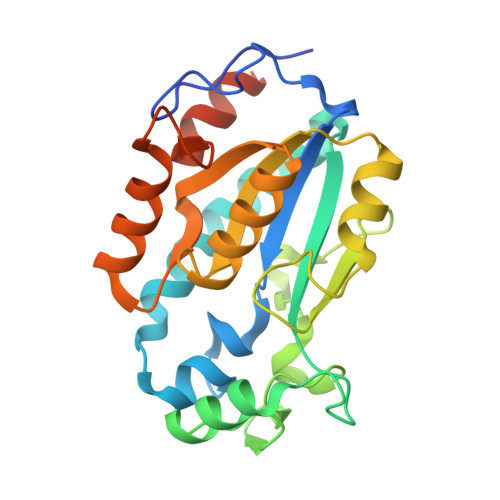Discovery of an ultraspecific triuret hydrolase (TrtA) establishes the triuret biodegradation pathway.
Tassoulas, L.J., Elias, M.H., Wackett, L.P.(2020) J Biol Chem 296: 100055-100055
- PubMed: 33172891
- DOI: https://doi.org/10.1074/jbc.RA120.015631
- Primary Citation of Related Structures:
6XIX, 6XJ4, 6XJE, 6XJM, 6XK1 - PubMed Abstract:
Triuret (carbonyldiurea) is an impurity found in industrial urea fertilizer (<0.1% w/w) that is applied, worldwide, around 300 million pounds each year on agricultural lands. In addition to anthropogenic sources, endogenous triuret has been identified in amoeba and human urine, the latter being diagnostic for hypokalemia. The present study is the first to describe the metabolic breakdown of triuret, which funnels into biuret metabolism. We identified the gene responsible for triuret decomposition (trtA) in bacterial genomes, clustered with biuH, which encodes biuret hydrolase and has close protein sequence homology. TrtA is a member of the isochorismatase-like hydrolase (IHL) protein family, similarly to BiuH, and has a catalytic efficiency (k cat/ K M ) of 6 x 10 5 M -1 s -1 , a K M for triuret of 20 μM, and exquisite substrate specificity. Indeed, TrtA has four orders of magnitude less activity with biuret. Crystal structures of TrtA in apo and holo form were solved and compared with the BiuH structure. The high substrate selectivity was found to be conveyed by second shell residues around each active site. Mutagenesis of residues conserved in TrtA to the alternate consensus found in BiuHs revealed residues critical to triuret hydrolase activity but no single mutant evolved more biuret activity, and likely a combination of mutations is required to interconvert between TrtA, BiuH functions. TrtA-mediated triuret metabolism is relatively rare in recorded genomes (1-2%), but is largely found in plant-associated, nodulating, and endophytic bacteria. This study suggests functions for triuret hydrolase in certain eukaryotic intermediary processes and prokaryotic intermediary or biodegradative metabolism.
Organizational Affiliation:
Department of Biochemistry, Biophysics & Molecular Biology, University of Minnesota, Minneapolis, Minnesota, USA; BioTechnology Institute, University of Minnesota, St Paul, Minnesota, USA.














